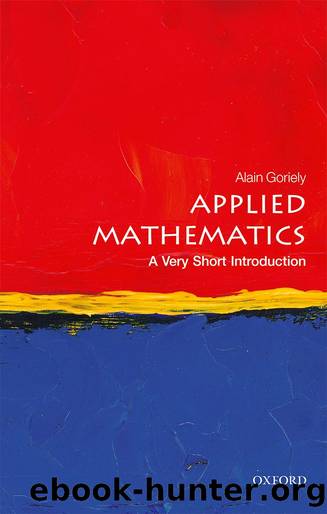Applied Mathematics: A Very Short Introduction by Alain Goriely

Author:Alain Goriely
Language: eng
Format: azw3
Tags: Applied, Mathematics, Science, General
ISBN: 9780191068881
Publisher: Oxford University Press
Published: 2018-02-13T18:37:57.797683+00:00
What Poincaré discovered in the solutions of the three‐body problem was the possibility of what modern scientists now understand as chaos. The solutions can be so complicated that they would turn back onto themselves and form, in the words of Poincaré, ‘a type of trellis, tissue, or grid with infinitely fine mesh’. This initial discovery is connected to the birth of the theory of chaos and dynamical systems, as discussed later in this chapter.
Tautologies: the tale of rabbits and wolves
In physics, differential equations express the basic, local conservation of physical quantities such as energy and mass. When modelling a phenomenon, differential equations express simple fundamental relationships that are valid when small changes of a quantity are considered. Some of these relations are so trivial that they would seem useless at first sight. Yet, the cumulative effect of small trivial increments can lead to great complexity as was shown by Poincaré. Solving these equations allows us to understand how complex effects are born out of simple interactions.
Let us consider a situation that does not rely on any knowledge of physics: the highly simplified interaction of a prey with a predator in a homogeneous environment, say rabbits and wolves. In our ideal world, rabbits have as much food as they want and wolves can only rely on the rabbit population for nourishment. We assume that in the absence of wolves, the rabbit population would naturally grow without limitation. Since each pair of rabbits can create new rabbits, the rate of growth is proportional to the population itself. This is exactly what happened in 1859 in Australia when twenty‐four rabbits were released. It was said at the time that ‘The introduction of a few rabbits could do little harm and might provide a touch of home, in addition to a spot of hunting.’
When the population is large enough, it is reasonable to assume that the number of rabbits can be modelled by a continuous variable R(t) giving the rabbit population at time t. By themselves, the simplest model is to assume that the rate of change of the population is proportional to the population itself. The rate of change of the population is simply its derivative in time. Therefore, in terms of differential equations, this statement is written
Download
This site does not store any files on its server. We only index and link to content provided by other sites. Please contact the content providers to delete copyright contents if any and email us, we'll remove relevant links or contents immediately.
| Applied | Geometry & Topology |
| History | Infinity |
| Mathematical Analysis | Matrices |
| Number Systems | Popular & Elementary |
| Pure Mathematics | Reference |
| Research | Study & Teaching |
| Transformations | Trigonometry |
Modelling of Convective Heat and Mass Transfer in Rotating Flows by Igor V. Shevchuk(6203)
Weapons of Math Destruction by Cathy O'Neil(5779)
Factfulness: Ten Reasons We're Wrong About the World – and Why Things Are Better Than You Think by Hans Rosling(4455)
Descartes' Error by Antonio Damasio(3139)
A Mind For Numbers: How to Excel at Math and Science (Even If You Flunked Algebra) by Barbara Oakley(3076)
Factfulness_Ten Reasons We're Wrong About the World_and Why Things Are Better Than You Think by Hans Rosling(3025)
TCP IP by Todd Lammle(2982)
Applied Predictive Modeling by Max Kuhn & Kjell Johnson(2859)
Fooled by Randomness: The Hidden Role of Chance in Life and in the Markets by Nassim Nicholas Taleb(2834)
The Tyranny of Metrics by Jerry Z. Muller(2819)
The Book of Numbers by Peter Bentley(2744)
The Great Unknown by Marcus du Sautoy(2516)
Once Upon an Algorithm by Martin Erwig(2457)
Easy Algebra Step-by-Step by Sandra Luna McCune(2435)
Lady Luck by Kristen Ashley(2386)
Practical Guide To Principal Component Methods in R (Multivariate Analysis Book 2) by Alboukadel Kassambara(2358)
Police Exams Prep 2018-2019 by Kaplan Test Prep(2334)
All Things Reconsidered by Bill Thompson III(2242)
Linear Time-Invariant Systems, Behaviors and Modules by Ulrich Oberst & Martin Scheicher & Ingrid Scheicher(2210)
